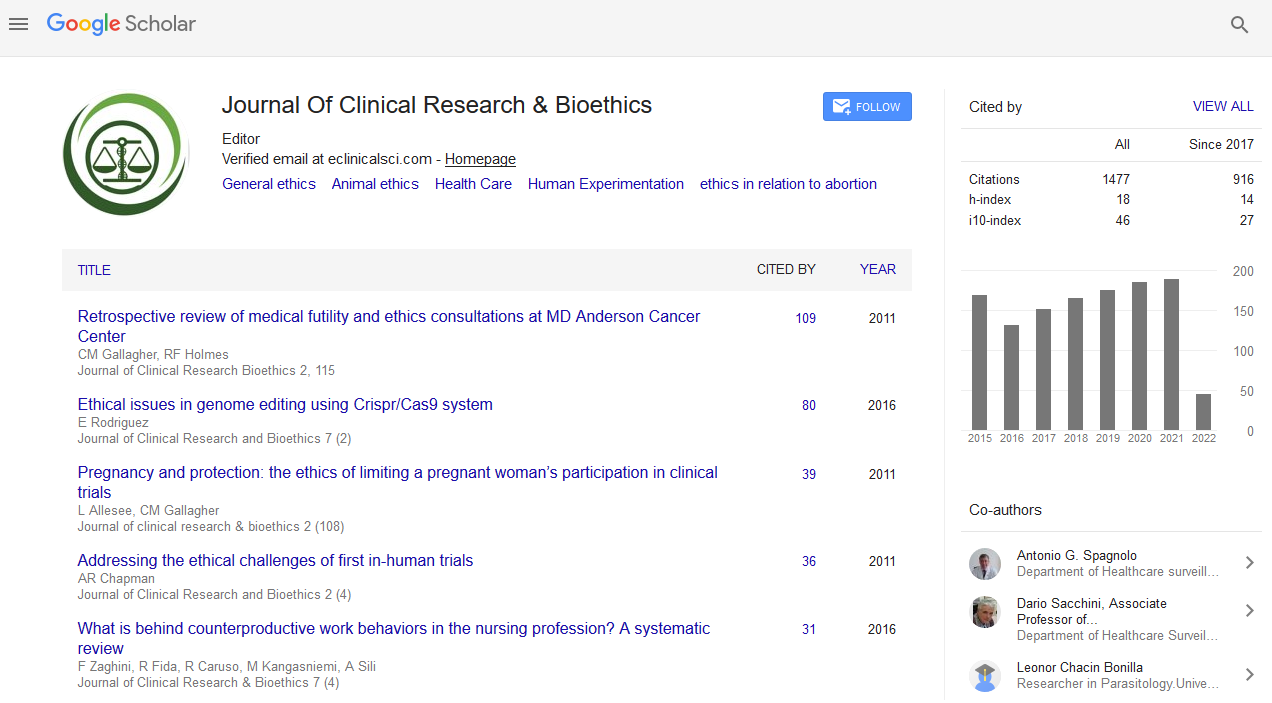PMC/PubMed Indexed Articles
Indexed In
- Open J Gate
- Genamics JournalSeek
- JournalTOCs
- RefSeek
- Hamdard University
- EBSCO A-Z
- OCLC- WorldCat
- Publons
- Geneva Foundation for Medical Education and Research
- Google Scholar
Useful Links
Share This Page
Journal Flyer

Open Access Journals
- Agri and Aquaculture
- Biochemistry
- Bioinformatics & Systems Biology
- Business & Management
- Chemistry
- Clinical Sciences
- Engineering
- Food & Nutrition
- General Science
- Genetics & Molecular Biology
- Immunology & Microbiology
- Medical Sciences
- Neuroscience & Psychology
- Nursing & Health Care
- Pharmaceutical Sciences
Abstract
Verbal Permission to Obtain Clinically Urgent Bio-Specimens for a Paediatric Biobank
Tamsin E Tarling, Caron Strahlendorf, Kirk R Schultz, Ruth Milner and Suzanne M Vercauteren
Objective: Consenting parents/guardians of paediatric patients suspected of a haematological malignancy for research is often a challenging process. However, without consent extra bone marrow cannot be taken for biobanking purposes. The Childhood Cancer and Blood Research (CCBR) BioBank was established to collect biospecimens from paediatric patients with haematological malignancies and blood disorders. Bio-specimens are also collected from patients with non-haematological malignancies that may have bone marrow involvement. Most patients present acutely with a potential diagnosis of childhood leukaemia, therefore there is considerable anxiety and distress at this time. Due to the acute nature of the presentation there is generally very little time between admission and the diagnostic procedure.
Method: To allow appropriate consideration to participate in biobanking a two stage consenting process was established with initial verbal permission for bio-specimen collection followed by full written consent at a later more appropriate time. A survey was conducted in the Haematology/Oncology/Blood and Marrow Transplant (Hem/Onc/ BMT) clinic of BC Children’s Hospital to obtain opinions of patients and their families about biobanking in general and the consenting process used for the CCBR BioBank.
Results: Most eligible patients (93%) consent to the CCBR BioBank. The majority of participants (71%) preferred the two step process. Generally, participants understood and freely expressed their opinions about biobanking and the ethical issues associated. Participants felt helpful, honourable, hopeful or a combination of these having participated in the CCBR BioBank.
Conclusions: We found that verbal permission to collect a biobank specimen followed by formal written consent is an effective method of engaging informed patient participation in a biobank and is actually preferred by participants as a method of obtaining consent for biobanking in an urgent paediatric setting.
Terminology: For the purposes of this article, we have chosen to use the term bio-specimen or specimen when referring to the biological specimens that are obtained for biobanking. However, in our consent forms and in the survey that we conducted we use the term “sample” as we feel that this is easier for a layperson to understand. Therefore the terms bio-specimen, specimen and sample may be used interchangeably in this document. Additionally, when individuals are first approached in the hospital, we refer to them as patients. Once they have agreed to either participate in the CCBR BioBank or in the CCBR BioBank survey they become participants. The terms patient(s) or participant(s) refers to both the child and the parent or legal guardian.


